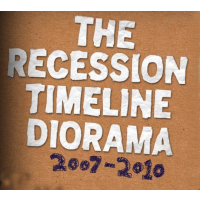Museum of The Great Recession: A Plan for Cultural Enrichment
 (original illustration: Jess Bachman)
(original illustration: Jess Bachman)
Museums were hammered during the Great Recession, as many of the wealthy patrons who helped bring the world to its knees cut back drastically on their support for the arts. So it seems only fitting that a new museum should be built in California—the spiritual, if not financial, home of the Crash—to tell the story for future generations.
At least it seems that way to Joe Mathews, writing at Zocalo Public Square, a not-for-profit Ideas Exchange. He gives Californians credit for practically inventing the global conflagration between 2007 and 2009, pursuing the Great American Dream of home ownership with a desperate, empowered gusto that Countrywide Financial was more than happy to turn into massive consumer debt.
Countrywide’s risky subprime loans were a major source of the innovative banking securities that sliced and diced the American Dream into a multi-episodic, tragic saga decline, streamed live into people’s souls for too many seasons. This cries out for at least a few dioramas.
Mathews has a vision for the museum, but would rely on information from the federal Financial Crisis Inquiry Commission to guide the choices of permanent exhibits. The museum director would be former California State Treasurer Phil Angelides, the commission chairman.
The Walt Disney Company could supply Lincoln-like animatronic versions of ex-Federal Reserve Chairman Ben Bernanke and ex-Treasury Secretary Timothy Geithner in one room to take questions about shadow banking, credit default swaps “and that whole business with Fannie and Freddie.”
Museum-goers with headphones could hear stories of misery from homeowners who tried to renegotiate loans with bankers as their home values plunged underwater and their jobs disappeared along with their futures. For the younger, more physically-engaged crowd, an interactive exhibit would allow individuals to “compete with former professional robo-signers of foreclosure affidavits to see who could review and sign more mortgage documents (without reading anything, of course) in less than a minute.”
The Museum of Jurassic Technology could curate a room devoted to nutball right-wing economic hallucinations and fanciful credit-rating agency reports. Another room would feature performance art―a millennial sitting in his childhood bedroom, the floor covered with job applications.
One sensed that Mathews could easily have detailed plans for a museum larger than The Louvre, and he also struggled to decide on a home for it. Again, so many choices. California’s has had a couple of bankrupt cities that have cheap property and huge symbolic value. Vacant malls are strewn about. The Countrywide headquarters in suburban Los Angeles County is empty and available.
Mathews says the museum is important because we should never forget what happened and it shouldn’t be left to Wall Street to build it. That’s probably not a concern for millions of Americans who carry with them the artifacts,
The Museum of Jurassic Technology—home, at times, to a species of bat that flies through solid objects, a bet-wetting remedy of mice-on-toast and a memory researcher who, in the opinion of the Los Angeles Times, most likely never existed—aims to capture what it says is the flavor of the roots of early natural history museums: “Incongruity born of the overzealous spirit in the face of unfathomable phenomena.”
Sounds like future welcoming words over the portico at the Museum of the Great Recession.
–Ken Broder
To Learn More:
What California Needs Is a Museum of The Great Recession (by Joe Mathews, Zocalo Public Square)
Museums Suffer the Art World's Biggest Fallout (by Peter Plagens, Newsweek)
The Arts in a Time of Recession (by Marque-Luisa Miringoff and Sandra Opdycke, The International Journal of the Arts in Society) (pdf)
- Top Stories
- Controversies
- Where is the Money Going?
- California and the Nation
- Appointments and Resignations
- Unusual News
- Latest News
- California Forbids U.S. Immigration Agents from Pretending to be Police
- California Lawmakers Urged to Strip “Self-Dealing” Tax Board of Its Duties
- Big Oil’s Grip on California
- Santa Cruz Police See Homeland Security Betrayal in Use of Gang Roundup as Cover for Immigration Raid
- Oil Companies Face Deadline to Stop Polluting California Groundwater





